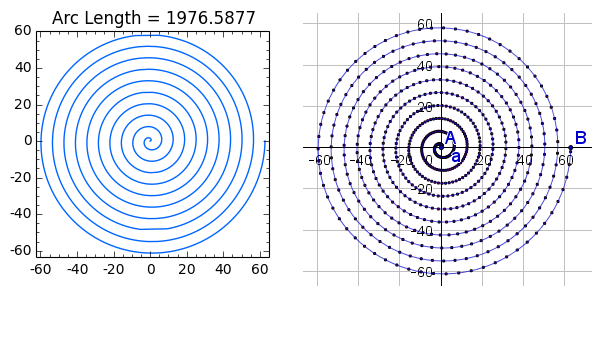Parametric Arc Length

With Parametric equations, the arc length formula is written with equation \eqref{1}. $$ArcLength=\int_{a}^{b}\sqrt{1+\left(\frac{dy/dt}{dx/dt}\right)^{2}}\,dx \tag{1} \label{1}$$ and for convenience might be expressed as $$f(t)=\sqrt{\left(\frac{dx}{dt}\right)^{2}+\left(\frac{dy}{dt}\right)^{2}}dt$$ Example: Let $x(t)=t\cdot cos(t)$ and $y(t)=t\cdot sin(t).$ This curve will be a really nice spiral between $0$ and $20\pi.$
from sage.symbolic.integration.integral import definite_integral
var('t')
x(t)=t*cos(t)
y(t)=t*sin(t)
L1=parametric_plot((x(t),y(t)),(t,0,20*pi),rgbcolor=hue(0.6))
show(L1,figsize=4,axes=false,frame=true)
f(t)=sqrt((diff(x(t),t))^2+(diff(y(t),t))^2)
definite_integral(f(t),t,0,20*pi).n()
var('t')
x(t)=t*cos(t)
y(t)=t*sin(t)
L1=parametric_plot((x(t),y(t)),(t,0,20*pi),rgbcolor=hue(0.6))
show(L1,figsize=4,axes=false,frame=true)
f(t)=sqrt((diff(x(t),t))^2+(diff(y(t),t))^2)
definite_integral(f(t),t,0,20*pi).n()
Example 1: 1.20.6. Calculate the length of a cycloid curve for a wheel of radius 8 inches.
The cycloid parametric equations are $x(t)=r(t-sin(t))$ and $y(t)=r(1-cos(t)).$